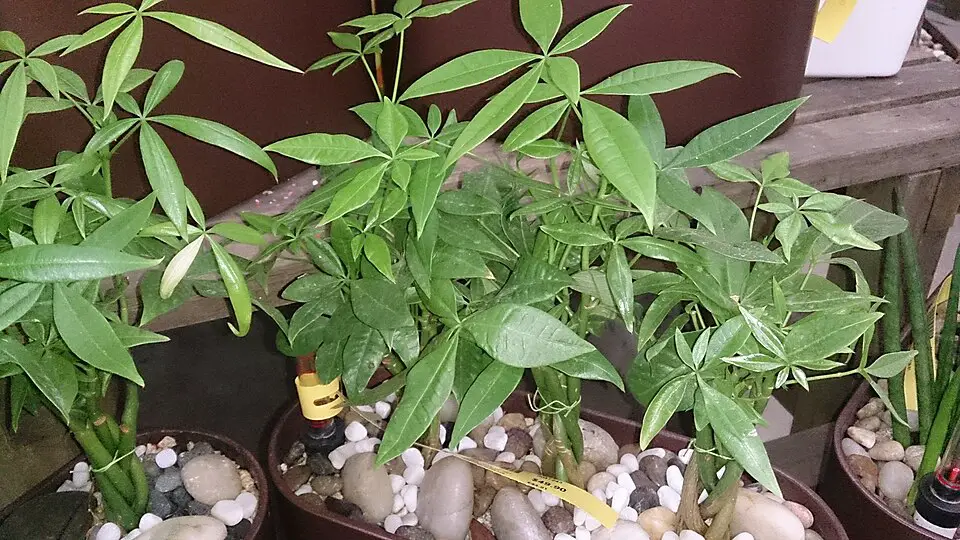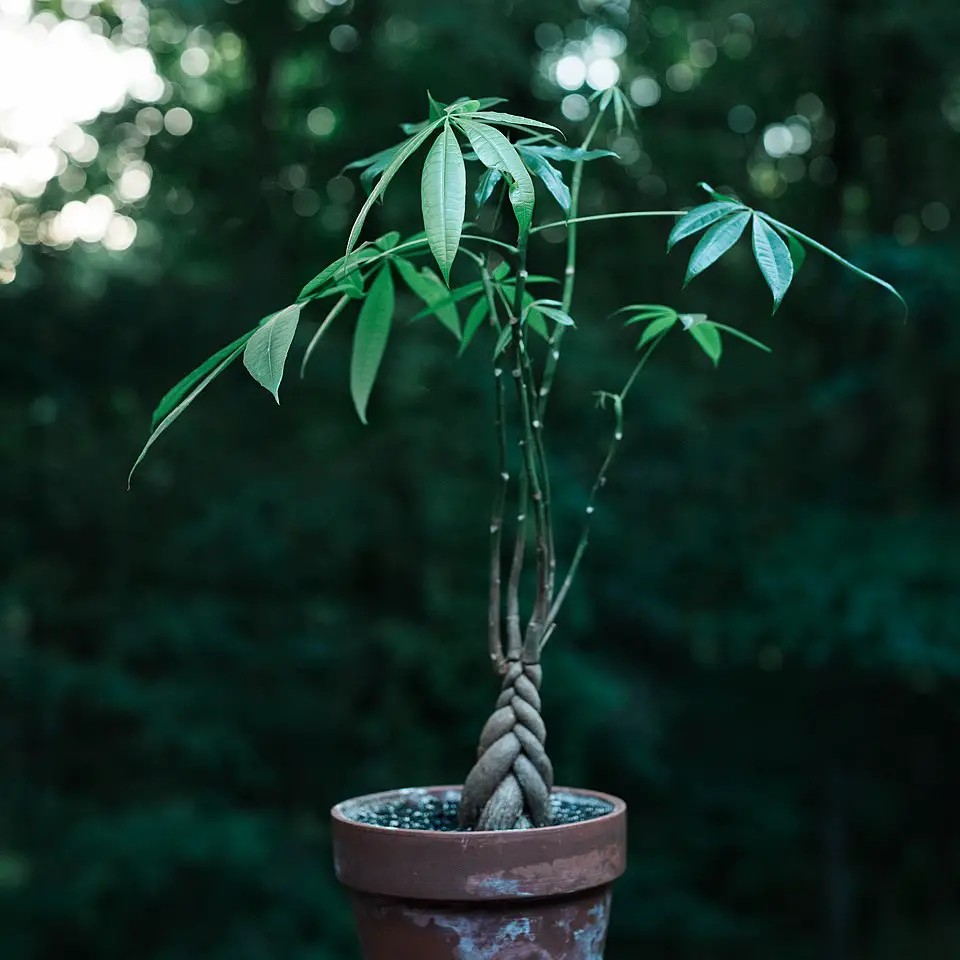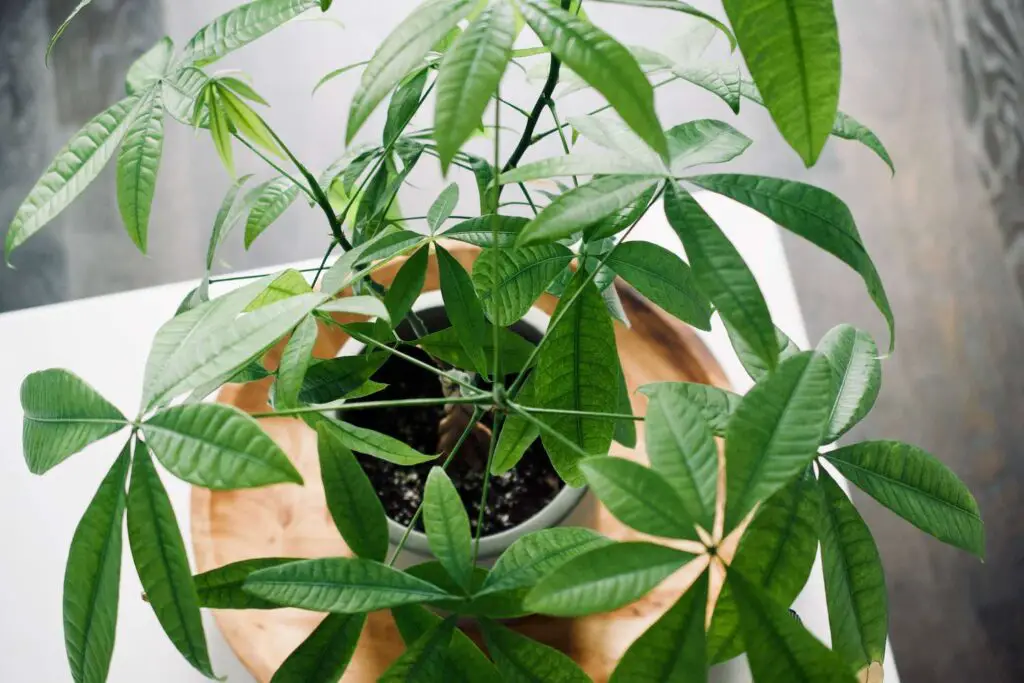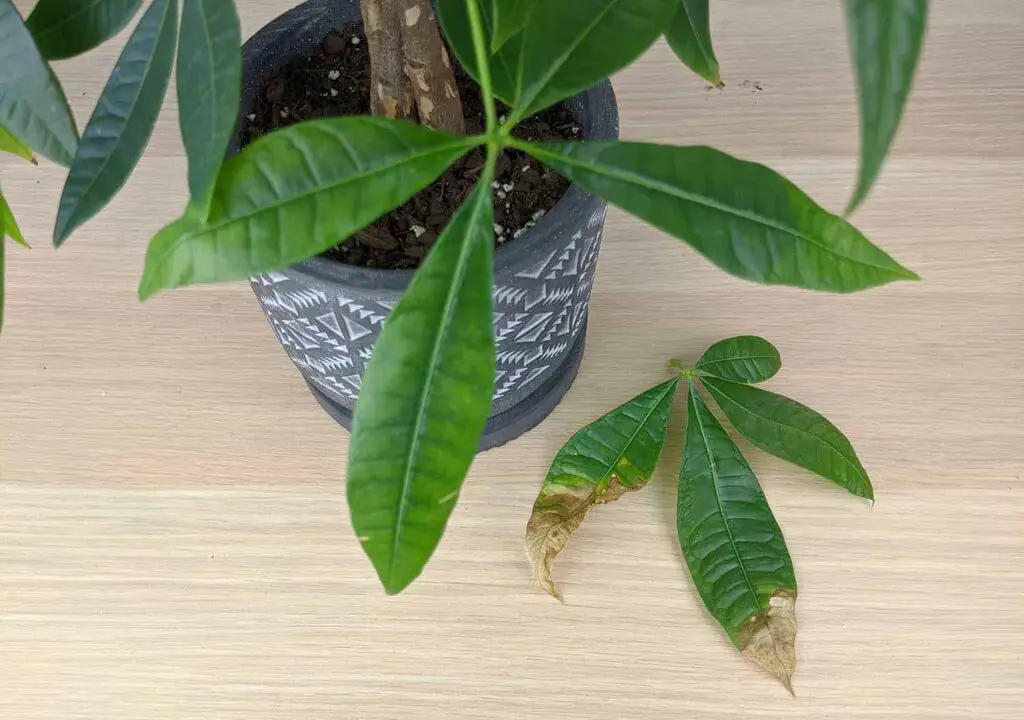The key to keeping a Money Tree healthy is to water it properly. Avoid overwatering by ensuring the soil dries out between watering sessions, using well-draining soil, and monitoring humidity levels. Always check for root rot signs, which occur from excessive moisture.
Understanding the Money Tree
The Money Tree, scientifically known as Pachira aquatica, is a popular houseplant that symbolizes good luck and prosperity. Native to Central and South America, this plant thrives in tropical conditions. Its unique braided trunk and lush green leaves make it an attractive addition to any home or office space.

Caring for a Money Tree involves several key aspects, with watering being the most critical. Many new plant owners struggle with finding the right balance in watering. Too much water can lead to serious issues like root rot, while too little can cause the plant to wilt. Understanding how to properly water your Money Tree is essential for its long-term health.
Watering Requirements
Money Trees prefer to be watered thoroughly but infrequently. The frequency of watering will depend on various factors including the season, the size of the pot, and the humidity of your environment. Here are some important considerations:
- Soil Type: Use well-draining soil specifically designed for indoor plants.
- Pot Size: Ensure that your pot has drainage holes to prevent excess water from accumulating.
- Environmental Factors: Monitor temperature and humidity levels in your home, as these can affect how quickly the soil dries out.
During the growing season in spring and summer, your Money Tree may require more frequent watering. In contrast, during fall and winter, you may need to reduce watering as the plant enters dormancy.

Signs of Overwatering
Overwatering is one of the most common mistakes that plant owners make. Recognizing the signs early can save your Money Tree from serious damage. Here are some symptoms to look out for:
- Yellowing Leaves: Leaves may start to turn yellow and drop off if they are receiving too much water.
- Mushy Stems: Stems that feel soft or mushy indicate that root rot may be setting in.
- Foul Odor: A rotten smell coming from the soil often means that the roots are decomposing due to excess moisture.
How to Water Properly
To avoid overwatering your Money Tree, follow these guidelines:
- Check Soil Moisture: Before watering, stick your finger about an inch into the soil. If it feels dry, it’s time to water.
- Water Thoroughly: When you do water, do so until water drains out of the bottom of the pot. This ensures that all roots receive moisture.
- Empty Excess Water: After watering, make sure to empty any excess water from the saucer under the pot within a few hours.
By implementing these practices, you can ensure that your Money Tree thrives without falling victim to overwatering issues.

Adjusting for Seasons
As seasons change, so do the watering needs of your Money Tree. During warmer months, you may find that your plant uses more water due to increased evaporation and growth. In colder months, however, you should scale back on watering as the plant’s growth slows down. Keeping an eye on environmental factors will help you make necessary adjustments.
In addition to adjusting water frequency based on seasons, consider using a moisture meter. This tool can provide more accurate readings of soil moisture levels and help you decide when it’s time to water.
| Season | Watering Frequency |
|---|---|
| Spring/Summer | Every 1-2 weeks |
| Fall/Winter | Every 2-4 weeks |
By understanding these seasonal adjustments and implementing proper watering techniques, you can maintain a healthy and thriving Money Tree.
Identifying the Right Soil for Your Money Tree
The type of soil you use for your Money Tree significantly influences its watering needs. Proper soil not only affects how well water drains but also supports the overall health of the plant. Selecting the right mix is essential to prevent overwatering issues.

Characteristics of Ideal Money Tree Soil
When choosing soil for your Money Tree, look for a mix that has the following characteristics:
- Well-Draining: The soil should allow excess water to flow out easily, preventing root rot.
- Aeration: A good mix should provide enough aeration to the roots, promoting healthy growth.
- Nutrient-Rich: Look for a soil that contains organic matter to support the plant’s nutritional needs.
You can create your own soil mix or purchase a pre-made potting mix designed for succulents or cacti, as these often have the ideal drainage properties for a Money Tree.
How to Repot Your Money Tree
Repotting your Money Tree is an important task that can help manage its growth and watering needs. As the plant grows, it may outgrow its pot, leading to potential watering issues. Here’s how to repot your Money Tree effectively:
- Choose the Right Time: Spring is the best time to repot, as this coincides with the plant’s active growth phase.
- Select a Larger Pot: Choose a pot that is one size larger than the current one. Ensure it has drainage holes.
- Prepare the Soil: Use a well-draining potting mix as discussed earlier.
- Remove the Plant: Gently take the Money Tree out of its current pot. Be careful not to damage the roots.
- Examine the Roots: Check for any signs of rot or damage. Trim away any unhealthy roots with clean scissors.
- Position the Plant: Place the Money Tree in its new pot and fill it with fresh soil, ensuring that the root ball remains at the same level it was previously.
- Water Thoroughly: After repotting, water the plant well until water drains from the bottom.
Repotting not only provides more space for growth but also refreshes the soil, which can help with moisture retention and drainage.
Humidity Levels and Their Impact on Watering
The humidity level in your home can greatly affect how often you need to water your Money Tree. This tropical plant thrives in higher humidity but can adapt to average household conditions. However, too much or too little humidity can lead to problems.
Optimal Humidity Levels
The ideal humidity range for a Money Tree is between 40% and 60%. If your home is drier, especially during winter months, you may need to adjust your watering habits accordingly. Here are some tips:
- Use a Humidifier: If your home is dry, consider using a humidifier in the room where your Money Tree is located.
- Mist the Leaves: Lightly misting the leaves can help maintain humidity levels around the plant.
- Avoid Drafts: Keep your Money Tree away from air conditioning vents and heaters, as these can dry out the air around it.
Common Myths About Watering Money Trees
>There are several misconceptions about watering Money Trees that can lead to improper care. Understanding these myths can help you make better decisions regarding your plant’s needs.
- Myth 1: Watering more frequently will make my plant grow faster. This is false; overwatering can harm growth and lead to root rot.
- Myth 2: All plants need water every week. This varies; some plants may require less frequent watering depending on their environment.
- Myth 3: Yellow leaves always mean overwatering. This is not always true; yellow leaves can also indicate nutrient deficiencies or pest issues.
By recognizing these myths, you can better understand your Money Tree’s actual needs and avoid common pitfalls in care.
Watering Techniques for Your Money Tree
Proper watering techniques are essential to the health of your Money Tree. Understanding how to water effectively can prevent the common issues associated with overwatering. Here are some techniques to consider:
Bottom Watering
Bottom watering is a method where water is applied to the bottom of the pot instead of the top. This technique encourages the roots to grow downwards and can help prevent overwatering. Here’s how to do it:
- Fill a Sink or Basin: Place your potted Money Tree in a sink or basin filled with water.
- Allow Soil to Absorb Water: Let the pot sit for about 15-30 minutes, allowing the soil to absorb moisture from the bottom.
- Check Soil Moisture: After soaking, check the top of the soil. If it feels moist, it is time to remove it from the water.
This method ensures that the soil remains evenly moist without saturating the roots at the top.
Using a Watering Can
If you prefer traditional watering methods, using a watering can is also effective. However, proper technique is crucial:
- Water Evenly: Pour water evenly across the surface of the soil. Avoid concentrating water in one area.
- Watch for Drainage: Ensure that excess water drains from the bottom of the pot. If it doesn’t, adjust your watering amount.
- Avoid Watering Leaves: Try to keep water off the leaves, as this can lead to fungal issues.
Seasonal Adjustments in Watering Practices
As
previously mentioned, seasonal changes greatly affect your Money Tree’s watering needs. It’s crucial to adjust your watering practices accordingly to maintain a healthy plant. Here are some tips for each season:
Spring and Summer
During these warmer months, your Money Tree is actively growing and will require more frequent watering. Pay attention to the following:
- Increase Frequency: You may need to water every 1-2 weeks, depending on how quickly the soil dries out.
- Monitor Growth: New growth can indicate that your plant needs more water. If you see new leaves developing, be prepared to adjust your watering schedule.
Fall and Winter
As temperatures drop and daylight hours shorten, your Money Tree will enter a dormant phase. Adjust your watering accordingly:
- Reduce Frequency: Water every 2-4 weeks, depending on the soil moisture level.
- Check Soil Moisture: Make sure to check the soil more frequently during these months since it may take longer to dry out.
- Avoid Cold Drafts: Keep your plant away from cold drafts that can cause stress and affect its moisture needs.
Pest Management Related to Overwatering
Overwatering can create a favorable environment for pests. Recognizing and managing these pests is essential for maintaining a healthy Money Tree.
Common Pests Associated with Overwatering
Pests like spider mites, aphids, and fungus gnats thrive in overly moist environments. Here are some signs of infestations:
- Spider Mites: Look for fine webbing on the leaves, which may indicate a spider mite infestation.
- Aphids: These small bugs can often be found on new growth and may cause leaves to curl or distort.
- Fungus Gnats: Adult gnats are often seen flying around the plant, while larvae may be present in the soil.
Treatment Options
If you notice any of these pests, here are some treatment options you can consider:
- Neem Oil: A natural pesticide that can help control various pests without harming your plant.
- Insecticidal Soap: This product can be effective against soft-bodied insects like aphids.
- Soil Drying: Allowing the soil to dry out between waterings can help manage fungus gnats by removing their breeding ground.
By being proactive about pest management and understanding how overwatering affects both your Money Tree’s health and pest presence, you can create a thriving environment for your plant.
Maintaining a Healthy Money Tree Environment
In ad
dition to proper watering techniques and pest management, several other factors contribute to the overall health of your Money Tree. Understanding these elements will help you create an optimal environment for your plant.
Lighting Conditions
Light is a crucial factor in the growth and well-being of your Money Tree. Here are some essential points to consider when it comes to lighting:
- Bright, Indirect Light: Money Trees thrive in bright, indirect light. Too much direct sunlight can scorch the leaves, while too little light can hinder growth.
- Rotate Your Plant: To ensure even growth, rotate your Money Tree occasionally. This helps all sides receive equal light exposure.
- Monitor Leaf Color: If the leaves start to yellow or drop off, it may be an indication that your plant is not receiving adequate light.
Temperature Considerations
The ideal temperature range for a Money Tree is between 65°F to 80°F (18°C to 27°C). Keeping your plant within this range will promote healthy growth and reduce stress. Here are some temperature-related tips:
- Avoid Extreme Temperatures: Keep your Money Tree away from cold drafts, heaters, and air conditioning units.
- Temperature Fluctuations: Try to maintain a consistent temperature. Sudden changes can stress the plant and affect its watering needs.
Fertilization Needs
Providing your Money Tree with the right nutrients can enhance its growth and resilience. Here’s how to approach fertilization:
- Use a Balanced Fertilizer: A balanced, water-soluble fertilizer can provide essential nutrients during the growing season (spring and summer).
- Frequency: Fertilize every 4-6 weeks during active growth. Avoid fertilizing in fall and winter when the plant is dormant.
- Signs of Nutrient Deficiency: Yellowing leaves may indicate nutrient deficiencies; consider adjusting your fertilization routine if you notice this.
Final Thoughts
Caring for a Money Tree requires attention to various factors, with proper watering being the most critical. By understanding the unique needs of your plant—such as soil type, humidity levels, and seasonal changes—you can create a thriving environment that minimizes the risk of overwatering.
Remember that overwatering is not just about frequency; it also involves understanding your plant’s specific conditions. Factors like pot size, soil quality, and environmental humidity all play a role in how much water your Money Tree requires.
Additionally, maintaining proper lighting, temperature, and nutrition will enhance your plant’s health and resilience. Be proactive in monitoring for pests, as these can become more prevalent with improper watering practices.
With the right knowledge and care techniques, your Money Tree can flourish, bringing beauty and a sense of prosperity to your home. Embrace the journey of plant care, and enjoy watching your Money Tree thrive!
